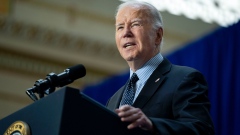Mar 31, 2021
Ontario locks down with virus 'killing faster and younger'
, Bloomberg News
'This is a man-made failure': Barberian's Steak House owner on Ontario shutdown
Ontario declared a four-week state of emergency after hitting a record for the number of COVID-19 patients in intensive care, driven by virus strains that are more contagious and dangerous.
The order imposes restrictions on businesses and residents across the Canadian province of 14.7 million people, beginning April 3. Restaurants won’t be allowed to serve customers except for takeout and delivery orders; indoor public events are banned, with a few exceptions. Supermarkets and pharmacies will operate at 50 per cent capacity and other retailers at 25 per cent.
Toronto and some other regions are already under similar rules. The government’s move tightens them further and extends them throughout the province, including Ottawa, Canada’s capital.
“The variants of concern are spreading rapidly. This is a new pandemic. We are now fighting a new enemy,” Ontario Premier Doug Ford said at a news conference Thursday afternoon. “Please understand folks, this decision weighs extremely heavy on me.”
Ontario joins a growing number of locations, including France and Italy, that are returning to strict limits on social interactions in an effort to slow the latest virus surge. Even as vaccinations continue, not every area has equal access. Novel variants are hastening the spread, and case rates are rising in many regions.
Ford and provincial health officials were asked why the government would extend measures that are largely the same as those already in place in Toronto and that have failed to prevent a rise in COVID-19 cases there.
But health officials argued that the situation in Toronto would be much worse if not for its lockdown, because the virus is more contagious than it was earlier in the pandemic.
“As the new variant spreads, you will see that Covid is killing faster and younger. It’s spreading far more quickly than it was before and we cannot vaccinate quickly enough to break this third wave,” Adalsteinn Brown, a doctor who is co-chair of the Ontario COVID-19 Science Advisory Table, said at a separate news conference Thursday.
Officials said the main variant spreading in the province -- known as B.1.1.7 -- is 50 per cent more lethal, twice as likely to send patients to intensive care units and three times as likely to require ventilation.
Variants of concern are also affecting younger patients: Almost half of those admitted to ICUs from March 15 to March 21 were under age 60.
Ontario hospitals are under strain, Brown said, with some entire families ending up in intensive care. There are 430 COVID-19 patients in ICUs.
Meanwhile, only 64 per cent of the over-80 population is vaccinated, excluding those at long-term care facilities. That drops to 39 per cent for people 75 to 79 years old and 16 per cent for those 70 to 74.
Overall, Canada has fully vaccinated less than 2 per cent of its population, according to the Bloomberg Vaccine Tracker.
In Canada, a recent rise in cases has meant tighter restrictions in a number of provinces. Quebec said Wednesday it would close schools and non-essential stores for 10 days in two regions. British Columbia, which had managed to dodge the worst of the pandemic, has closed indoor dining, worship services and most indoor fitness activities for three weeks.
Canada’s coronavirus efforts were complicated on Monday when health officials across Canada suspended the use of AstraZeneca Plc’s vaccine for people under 55 for fear of blood clots.
In Ontario, Ford has criticized Prime Minister Justin Trudeau’s government for failing to deliver adequate vaccine supplies to the province.
“The bottom line is, we need more time,” Ford said Thursday. “We need more time for our vaccine program to take hold.”
Ontario reported 2,557 new cases of COVID-19 on Thursday, bringing its total case count to 352,460, according to Public Health Ontario. Almost 17,100 residents have been hospitalized because of the disease, and 7,389 have died from it.
--With assistance from Zoe Ma and Michelle Fay Cortez.





